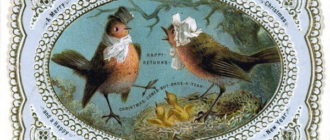
The Ninth Wave is the most famous and grandiose painting by Ivan Konstantinovich Aivazovsky. The canvas depicts a formidable sea dawn after a stormy night. A handful of survivors of the shipwreck are desperately fighting for their right to life by the boundless raging ocean.
Painting “The Ninth Wave” by Ivan Aivazovsky – the beauty of the sea and the will to live
The crushing blows of the salty waves completely deprived them of their strength. From the ship that seemed so strong, only a fragment of the mast remained. Four people cling to him. The fifth is trying to get out of the water and, barely grasping the skeleton, with the last of his strength supports his exhausted comrade, preventing him from slipping into the abyss.
Waves roll, rise and break with force. The depth of the abyss is felt under them. Another huge wave foaming along the crest is inevitably approaching this fragile island of hope. The impression of a sweeping hurricane is enhanced by the continuous movement of clouds.
But despite the drama of the situation, the picture does not evoke a feeling of doom. The newly-risen sun penetrates the rushing chaos of water and fog with its rays. The golden light of faith in salvation breaks through the violet-pink clouds. The horror of the storm is perceived by the viewer logically, but captivates with its beauty.

Description of the picture
Title of the painting: “The Ninth Wave”.
Author: Ivan Konstantinovich Aivazovsky (1817-1900).
Year of writing: 1850
Dimensions: 221 x 332 cm.
Style: Romanticism.
Genre: Marina.
Technique: Oil.
Material: Canvas.
Location: State Russian Museum, St. Petersburg.
Ivan Konstantinovich Aivazovsky is a famous Russian painter of the 19th century, recognized as the best marine painter in Europe, who managed to feel the soul of the sea. He has about six thousand seascapes on his account. The artist never painted his paintings from life, considering it unthinkable. But he had a phenomenal memory, closely and vigilantly observed the water element at different times of the day, made notes about its features.
The plot of the painting “The Ninth Wave” is based on the sailors’ belief about one, the most powerful wave, which is distinguished by its enormous size and irresistible force. The personal experience of the navigator helped the master to depict the movement of light, air and water plausibly. Traveling through Europe in 1844, he nearly fell victim to a shipwreck in the Bay of Biscay.
On the way from England to Spain, the ship with a young seascape on board fell into a violent storm. The captain was forced to sacrifice the masts. With great difficulty and major damage, the ship reached the coast. True, European newspapers were quick to report on the death of Ivan Aivazovsky. But the artist survived. Moreover, the fear of perishing did not suppress his ability to perceive and retain in his memory a living scene of an angry sea.
In 1850, Aivazovsky transferred the element he saw to the canvas.
He devoted 11 days to the painting “The Ninth Wave”. He worked quickly and with inspiration. Freely improvising, he filled the work with his feelings and observations. The master achieved the effect of transparency of sea water by overlaying many layers. At first, he depicted waveforms in a sweeping manner. Then I painted the details on the still wet surface.
At the very end, I applied glare with bold strokes. In the same 1850, “The Ninth Wave” was presented to the Moscow public. The success was deafening. The light effects and the brightness of the sun made such a strong impression on the visitors of the exhibition that some of them tried to look behind the canvas, hoping to see a candle there for artificial lighting.
And the famous collector and philanthropist Pavel Tretyakov immediately set out to buy the masterpiece. But he didn’t have time. Earlier, he admired the Emperor Nicholas I, and was acquired for the Hermitage. The work was transferred to the collection of the State Russian Museum in 1897.
The painting “The Ninth Wave” by Ivan Aivazovsky superbly conveys the incessant, inevitable and formidable movement of the elements, plunges the viewer into the rhythm of the waves, but postpones the tragic outcome, muffles it with colorful showiness and marks the rise of the romantic trend in Russian art.






